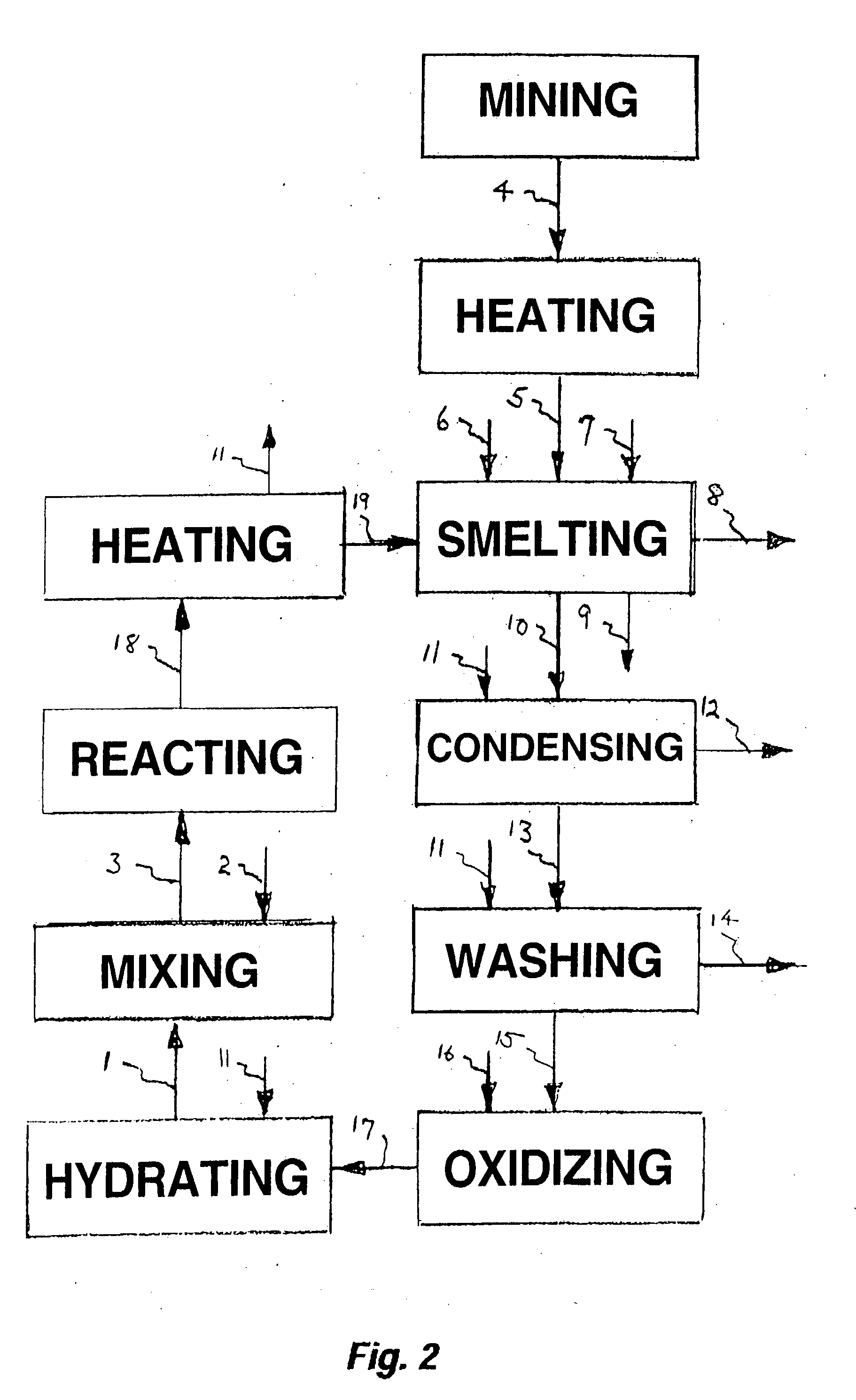Process for upgrading raw phosphate ore
a technology of raw phosphate ore and phosphate ore, which is applied in the direction of phosphates, inorganic chemistry, non-metallic elements, etc., can solve the problems of accumulating several thousand tons of excess fines, rapidly depleting lump rock supplies from this source, etc., and achieves high-purity phosphorus and increased yield
- Summary
- Abstract
- Description
- Claims
- Application Information
AI Technical Summary
Benefits of technology
Problems solved by technology
Method used
Image
Examples
example 2
[0115] The mineral fluorapatite in phosphate ores contains 3.77 percent fluorine, 42.2 percent P.sub.2O.sub.5 and the weight ratio of fluorine to P.sub.2O.sub.5 is 0.089. In most phosphate ores, however, the fluorine to P.sub.2O.sub.5 (F / P.sub.2O.sub.5) weight ratio is up to 50 percent higher than it is in fluorapatite because part of the phosphate normally present in the mineral has been replaced by carbonate and fluorine. Phosphate ore mined in middle Tennessee, for example, has a F / P.sub.2O.sub.5 weight ratio of 0.105.
[0116] The fluorapatite mineral does not readily lose fluorine by heating. This mineral has to be heated to temperatures well above 2000.degree. F. before significant amounts of fluorine volatilize. However, commercial phosphates begin to lose fluorine at temperatures well below 2000.degree. F. because the nonapatitic fluoride in the ore is more readily volatilized.
[0117] When beneficiated phosphate ore having a F / P.sub.2O.sub.5 weight ratio of 0.105 is heated and a...
example 3
[0118] Unbeneficiated phosphate ore from mines in middle Tennessee and having a F / P.sub.2O.sub.5, weight ratio of about 0.105 is heated to temperatures in the range of 2200.degree. F. to 2500.degree. F. to calcine and agglomerate the phosphatic material. The phosphatic material could be agglomerated at lower temperature because it contains more clay than beneficiated phosphate ore. Only about eight percent of the fluorine is volatilized and the calculated F / P.sub.2O.sub.5 weight ratio in the feedstock is 0.097 as compared with a ratio of 0.089 for heating in the temperature range 2600.degree. F. to 2730.degree. F. When the feedstock that had been heated to the temperature range 2200.degree. F. to 2500.degree. F. is smelted in electric furnaces it is evident more flourine is volatilized than for feedstock that had been heated to the temperature range 2600.degree. F. to 2730.degree. F., although a material balance is not determined.
example 4
[0119] Uncalcined and unagglomerated Florida hard rock is smelted in an electric furnace to investigate its smelting characteristics. The Florida hard rock has the following chemical composition: moisture, 1.7 percent; P.sub.2O.sub.5, 35.4 percent; CaO, 51.1 percent; SiO.sub.2, 2.7 percent; Fe.sub.2O.sub.3, 1.0 percent; Al.sub.2O.sub.3, 0.8 percent; CO.sub.2, 3.2 percent; and F, 3.9 percent. The F / P.sub.2O.sub.5 weight ratio is 0.110 and the percent P O in the phosphate-plus-silica is 27.2.
[0120] The smelting of Florida hard rock is compared with the smelting of feedstock that has been prepared from beneficiated raw phosphate ore from mines in middle Tennessee and has ?? been heated in the temperature range of 2600.degree. F. to 2700.degree. F. The feedstock has the following chemical composition: moisture, 0.0 percent; P.sub.2O.sub.5, 29.7 percent; SiO.sub.2, 18.8 percent; CaO, 41.7 percent; Fe.sub.2O.sub.3, 3.6 percent; F, 2.3 percent. The F / P.sub.2O.sub.5 weight ratio is 0.077 an...
PUM
| Property | Measurement | Unit |
|---|---|---|
| temperature | aaaaa | aaaaa |
| weight ratio | aaaaa | aaaaa |
| weight ratio | aaaaa | aaaaa |
Abstract
Description
Claims
Application Information
 Login to View More
Login to View More - R&D
- Intellectual Property
- Life Sciences
- Materials
- Tech Scout
- Unparalleled Data Quality
- Higher Quality Content
- 60% Fewer Hallucinations
Browse by: Latest US Patents, China's latest patents, Technical Efficacy Thesaurus, Application Domain, Technology Topic, Popular Technical Reports.
© 2025 PatSnap. All rights reserved.Legal|Privacy policy|Modern Slavery Act Transparency Statement|Sitemap|About US| Contact US: help@patsnap.com


